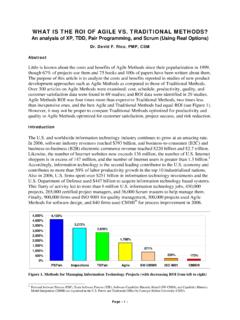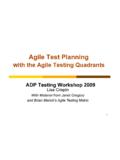Transcription of AGILE SUPPLY CHAIN: STRATEGY FOR …
1 AGILE SUPPLY chain : STRATEGY FORCOMPETITIVE ADVANTAGEI ntaher Marcus AMBEU niversity of South AfricaABSTRACTThe main objective of this paper is to explore the concept of AGILE SUPPLY chain and to determine thelink between AGILE SUPPLY chain and competitive advantage . The 21st century has led to increase inglobal competition and customer demands, with higher levels of turbulence and volatility in the mar-ket place. Businesses, economics and political environments are increasingly subjected to unex-pected shocks and discontinuities. As a result of these uncertainties, organisations today are facedwith a number of challenges in the SUPPLY chain which include among others the ability to meet upwith changes in demand variability, service improvements, lowering inbound costs, improving on-time delivery and shorter customer lead times.
2 In order to survive, companies need to respond toever-increasing levels of volatility in demand and focus their efforts upon achieving greater has the ability to rapidly respond to changes in market and customer demands as the bearerof competitive advantage . Therefore, companies need to re-design their SUPPLY chain to tackle issuesof agility in order to stay ahead in a highly competitive global Words: Agility; competitive advantage ; STRATEGY ; SUPPLY chain turbulent market conditions in the 21st century have heightened the need for more competitivestrategies to be developed for growth (Sanchez and Perez, 2007:681). Business, economics and thepolitical environments are increasingly subjected to unexpected shocks and discontinuities. Manystrategic issues that confront business today stem from: the new rules of competition, globalisationdown pressure on price and the customer taking control.
3 Also, as a result of the recent economicmeltdown, companies around the world are confronted by a perfect storm: frozen credit market andlong global recession. Events are moving so rapidly that it is almost impossible to access the impli-cation of the meltdown for the days ahead, let alone the years to come (Njoroge, 2009:2).The world is in the era of SUPPLY chain competition, where organisation no longer acts in isolation asan independent entity, but as a SUPPLY chain to create value delivery systems that are more respon-sive to fast-changing markets, more consistent and reliable (Christopher, 2005:29: Pandey and Gaug,2009:99). The core capabilities of a company lie in its ability to design and manage its SUPPLY chainin order to gain maximum advantage in the market where competitive forces are changing.
4 Newmanagerial practices and unique business models emerge and fade constantly as managers strive tohelp their companies succeed in this less-kind, less gentle and less predictable world (Fawcett, Ell-ram and Ogden, 2007). The best word to describe the global market today is volatility. Organisationshave to develop strategies in order to respond to ever-increasing levels of volatility in demand(Vinodh, Sundaraj and Devadasan, 2009:570). The big question is: How are SUPPLY chain executivescoping with the changing business environment and what STRATEGY can be implemented to achievecompetitive advantage in their SUPPLY chain ? Agility has the ability to rapidly respond to changes inmarket and customer demands as the bearer of competitive advantage .
5 Despite the obvious benefitsof agility, organisations are faced with challenges in implementing the measures necessary to in-crease their agility (Ismail and Sharifi, 2006:431). The paper explores the concept of AGILE supplychain and competitive advantage and presents a framework on the linkage between AGILE supplychain and competitive advantage . The remaining sections of the paper presents SUPPLY chain man-agement, SUPPLY chain strategies, competitive advantage in the SUPPLY chain , framework for aligningsupply chain and competitive strategies and of Global Strategic Management | V. 4 | N. 1 | 2010-June | | 5-17 | chain MANAGEMENTS upply chain management can be defined as the design and management of seamless, value-added process across organisational boundaries to meet the real needs of the end customer (Fawcett et al.)
6 ,(2007:8). As noted by Gansler, Luby and Kornberg (2004: 8), SCM is the management and control of all materials, funds and related information in the logistics process from the acquisition of raw materials to the delivery of finished products to the end user. More so, Hugo (2004:5) defines SCM as the management philosophy aimed at integrating a network of upstream linkages (sources of SUPPLY ), internal linkages inside the organization and downstream linkages (distribution and ulti-mate customer) in performing specific processes and activities that will ultimately create and opti-mize value for the customer in the form of products and services which are specifically aimed at satisfying customer demands.
7 Generally, SCM involves relationships and managing the inflow and outflow of goods, services and information (network) between and within producers, manufacturers and the consumers (Samaranayake, 2005:48).Although the definitions of SCM differ across authors, it exists in all organisational types and can be classified into three categories: a management philosophy, implementation of a management phi-losophy and as a set of management processes (Klemencic, 2006:13; Lambert, 2006:13). Successful SCM requires a change from managing individual functions to integrating activities into SCM processes. The SCM processes identified by members of The Global SUPPLY chain Forum are (Lambert, 2006:13): customer relation management; customer service management; demand management; order fulfilment; manufacturing flow management; supplier relationship management; product development and customici-alisation; and returns SUPPLY chain includes all activities, functions and facilities (directly or indirectly) in the flow and trans-formation of goods and services from the material stage to the end user (Sherer, 2005:79).
8 It is conceptual-ised as a network of companies from suppliers to end-users, with the intention of integrating SUPPLY and demand through coordinated company efforts. A SUPPLY chain links organisations in the upstream as well as the downstream flows of materials and information (Monczka Trent and Handfield, 2005:9). It comprises of a physical element and an information element. It is viewed as the formation of a value chain network consisting of individual functional entities committed to the controlled sharing of business data and processes. It consists of an upstream supplier network and downstream channel (Klemencic, 2006:7).Today; many organisations have become part of at least one SUPPLY chain . They have to perform equally well in order to achieve better objective of SCM is to maximise value in the SUPPLY chain .
9 The value a SUPPLY chain generates is the differences between what the final product is worth to the customer and cost the SUPPLY chain will in-cure to fulfil the customers request (Chopra and Meindl, 2010:22). SCM is about competing on value, collaborating with customers and suppliers to create a position of strength in the market-place based on value derived from end consumer (Chopra and Meindl, 2007:23). Within an organisa-tion, customer value is created through collaboration and cooperation to improve efficiency (lower cost) or market effectiveness (added benefits) in ways that are most valuable to key customers. Value is not inherent in products or services, but rather is perceived or experienced by the customer (Handfield, Monczka, Giunipero and Petterson, 2009:11).
10 The ultimate goal of a SCM process is to create customer and shareholder value, thus often called a value delivery encompasses planning, manufacturing and operations management necessary to bring a prod-uct to the market place, from the sourcing of materials to the delivery of the completed product. Some of the issues to consider when developing or managing a SUPPLY chain include integration, information technology, collaboration, customer and supplier relationships, partnerships, outsourcing and global issues as well as social and environmental issues (Borade and Nansod, 2007:112). SUPPLY chain STRATEGIESA SUPPLY chain STRATEGY is defined, relative to its competitors , the set of customer needs that it seeks to satisfy through its products and services (Chopra and Meindl, 2007: 22).







